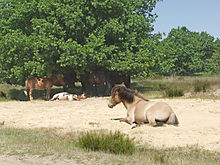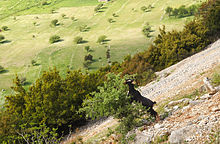Overgrazing
One speaks of overgrazing when animals, through browsing and / or standing up, stress the herbaceous plant cover of a pasture or a biotope faster or more than it can regenerate . This is the case with cattle stocking that is not adapted to the profitability of the area.
If the grazing pressure increases (number of animals or size of the herds , duration of grazing), the ecological carrying capacity soon reaches its limits: The result is overgrazing and soil degradation .
Historical view



In originally uninhabited natural landscapes , overgrazing by wild animals occurs only temporarily, as the populations of all animal and plant species in an ecosystem regulate each other and the number of individuals is therefore constantly adjusted to the current carrying capacity of the habitat. In this respect, overgrazing is basically a consequence of anthropogenic pasture use. Since the development of traditional livestock farming , there have been more or less clear structural changes from the former wilderness to anthropogenic landscapes . It is assumed that large parts of the Eurasian forest steppe (comparable to the Central European heaths ) only emerged as a result of the increased use of pasture: the tree vegetation was even more restricted than by the wild grazing animals. Due to the lower population numbers in the prehistory and the always extensive and often nomadic livestock keeping in areas that were previously the habitat of large herbivores, overgrazing damage is not to be assumed in these constellations.
Overgrazing is always to be feared when livestock farming is intensified in an inappropriate way : The prerequisites for this are, above all, strong population growth, the settling down of previously nomadic groups or the transition from subsistence to gainful farming , which necessitates surplus production . These are all factors that already appeared in the ancient civilizations. Dry ( arid ) natural pastures ( pastoralism ), whose sustainable use is only possible through traditional nomadism or a sophisticated, modern pasture management, are particularly sensitive . But even in damp ( humid ) areas, which are normally covered by forest, overgrazing damage has occurred since the Middle Ages, as the development of sandy heaths from the medieval commons of Central Europe shows.
Overgrazing, land degradation and desertification have increased dramatically worldwide since the industrial revolution . The arid areas of the earth ( deserts , steppes , dry savannas , dry forests , etc.) are particularly affected . Responsible in the old world is primarily the decline of the previously sustainable nomadism, which since the middle of the 20th century has increasingly transformed into unregulated and intensified mobile animal husbandry through state sedentary programs and market-economy influences . The keeping of excessive animal populations - for example in Africa - was only possible through the construction of wells for the cattle troughs, which were subsidized with external funds . In the arid regions of America, South Africa and Australia, since colonization, extensive stationary pasture management ( ranching ), which was installed by the Europeans and was oriented towards the market from the start, has been established. Here too, overgrazing damage has occurred in many regions, especially in the “Wild West” of the USA and in Patagonia .
Zonal differences
In the Mediterranean hard leaf zone with its hot and dry summers and winter rains ( Mediterranean climate ), overgrazing by flocks of goats and sheep leads to increased soil erosion ; if the erosion is already advanced, there is a risk of soil degradation. By anthropogenic and natural climate change may degenerate such areas are eligible for further expansion.
In cold steppes , overgrazing damage can occur due to the sensitive vegetation and the very short growth period. Examples can be found in sheep breeding in Iceland or intensified reindeer husbandry in Scandinavia.
Overgrazing occurs not only on natural pastures, but also in grassland management in moderate climates, which takes place on areas that were previously covered with forest. Here, grazing is appropriate if the “grassland” is sustainably maintained as a substitute society . Overgrazing, but above all undergrazing (which leads to shrubbery), can lead to the loss of the grassland. Overgrazing on grassland areas mainly leads to the spread of pasture weeds, which do not serve as fodder crops, due to the food preferences of the cattle. The species composition can also change as a result of damage caused by kicking. In Central Europe, overgrazing by cattle can often be recognized by the increased occurrence of footsteps ( plantain ), nutrient and acid indicators, easily regenerating grasses such as annual bluegrass Poa annua , couch grass A. repens and weeds (e.g. thistles ) (see also Pointer values according to Ellenberg ). In the damp pastures of Central Europe, this can also be rushes .
If excessive animal populations are kept continuously, the plants suitable for animal nutrition are reduced so much in the long term that the plant cover only consists of inedible or worthless plant species. Mountain locations or dry ( arid climates ), low-yield areas are particularly affected. The degree of coverage of the areas decreases with step in the further course, in extreme cases the plant cover even partially dies. This can lead to erosion of the topsoil , which makes repopulation by plants more difficult, and in extreme cases to desertification (desertification).
In damaged dry areas, shepherds often increase the proportion of goats, as these animals are particularly frugal and also make a living in overgrazed regions. However, this sets a vicious circle in motion, because goats graze the sward particularly deeply, which further intensifies the erosion.
See also
literature
- Joachim Radkau: Nature and Power: A World History of the Environment. 1st edition, CH Beck, Munich 2002. ISBN 3-406-48655-X .
Individual evidence
- ↑ Keyword load capacity in the online dictionary of Spektrum. Retrieved March 22, 2014.
- ↑ M. Bunzel-Drüke, C. Böhm, G. Finck, R. Kämmer, E. Luick, E. Reisinger, U. Riecken, J. Riedl, M. Scharf, O. Zimball: “Wilde Weiden - practical guide for year-round grazing in nature conservation and landscape development ”. Working group on biological environmental protection in the Soest district (ed.) - Sassendorf-Lohne 2008.
- ↑ Tarleton State University (ed. If applicable): The Study of the Human Past. Part C. Indus Valley Civilization. In: ArcheologyNotes2011. Study materials, Tarleton (Texas) 2011, p. 55.
- ↑ Winona LaDuke: Our Relations: Native Struggles for Land and Life. South End Press, Cambridge, 1999
- ↑ Clay Duval: Bison Conservation: Saving an Ecologically and Culturally Keystone Species . Duke University. Archived from the original on March 8, 2012.
- ^ "Holistic Land Management: Key to Global Stability" by Terry Waghorn. Forbes. 20 December 2012.
- ^ Roland Berger, Friedrich Ehrendorfer (ed.): Ecosystem Vienna: the natural history of a city. Böhlau Verlag, Vienna 2011, p. 678.
- ↑ A. Rosati, A. Tewolde, C. Mosconi, World Association for Animal Production (ed.): Animal Production and Animal Science Worldwide. Wageningen Academic Pub, 2005.
- ↑ Hartmut Esser (possibly ed.): Sociology: Social Action. Volume 3 edition, Campus, Frankfurt / M. 2000, ISBN 3-593-37146-4 . P. 184.
- ↑ Fred Scholz : Nomadism is dead. In Geographische Rundschau , Issue 5, 1999, pp. 248-255.
- ↑ see literature: Radkau p. 212.
- ↑ Wilfried Endlicher: Basic features of climate and soils. In: Natural Area Latin America: Geographic and Biological Foundations. Axel Borsdorf (Ed.), LIT Verlag, Vienna 2006, ISBN 3-8258-9369-3 , p. 89.



